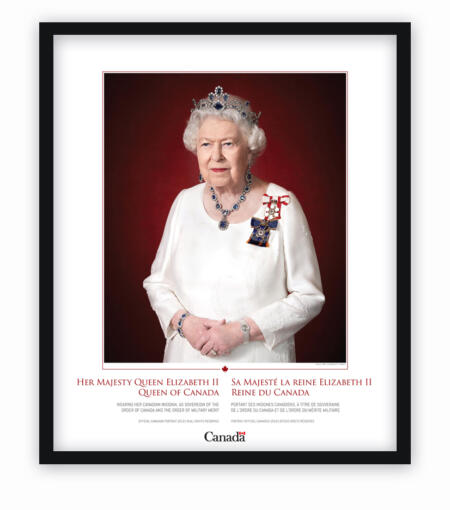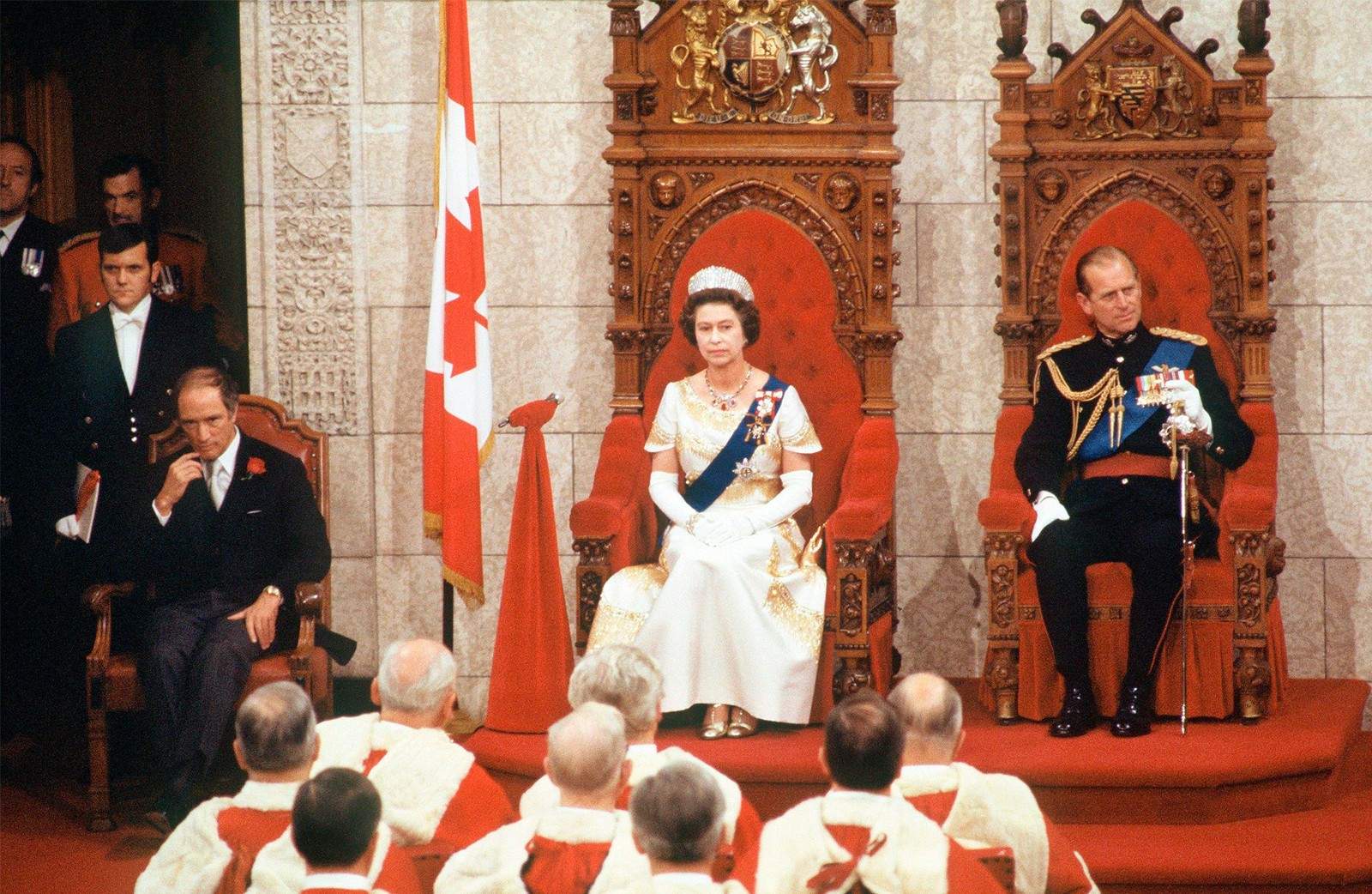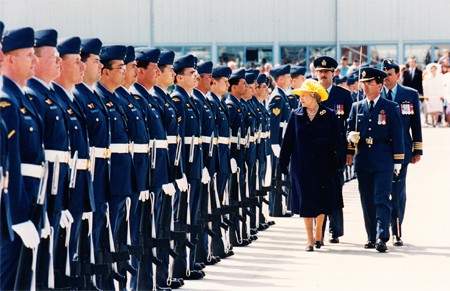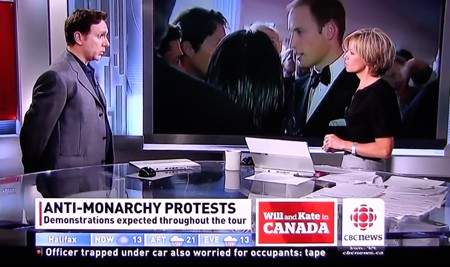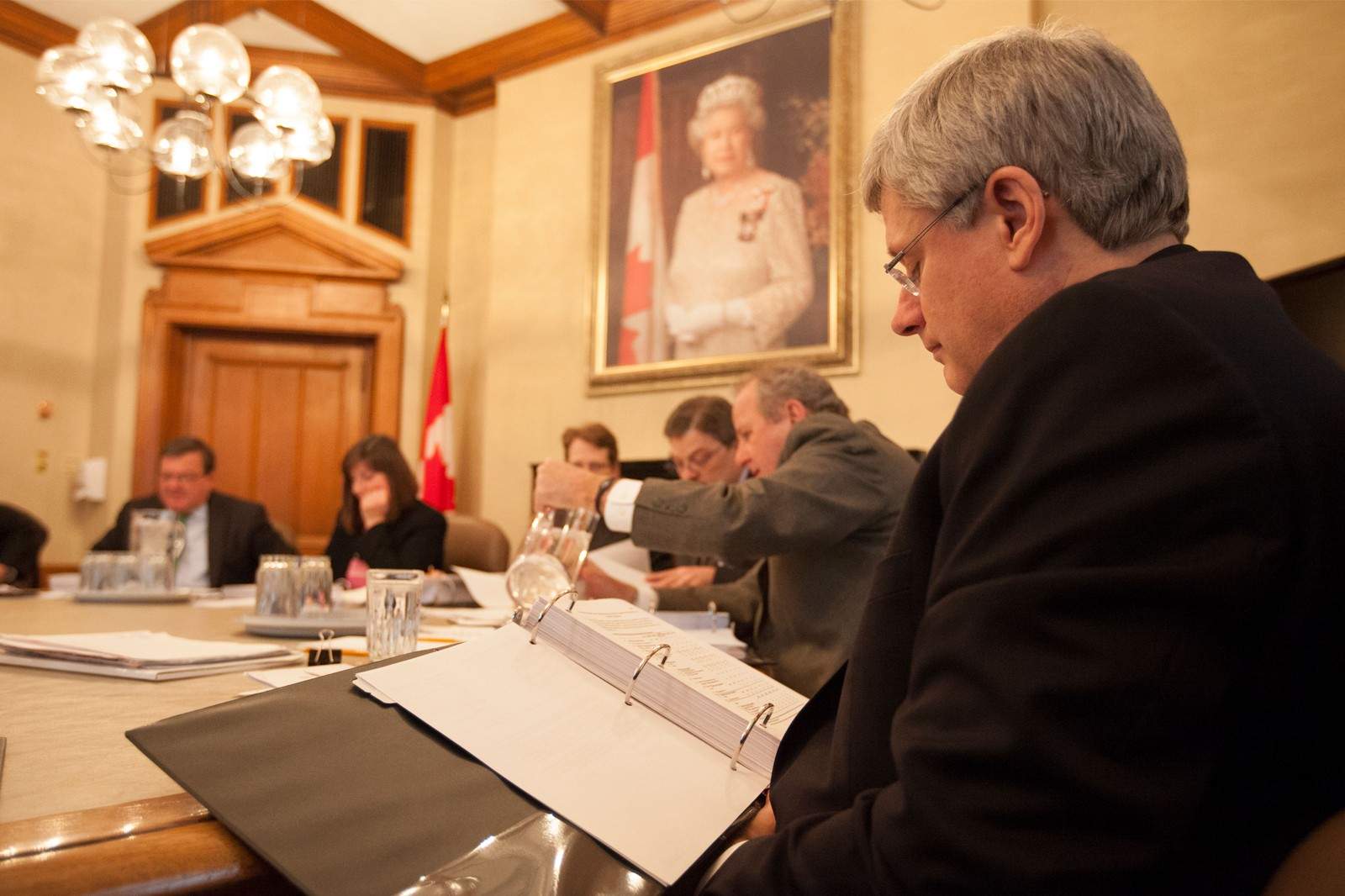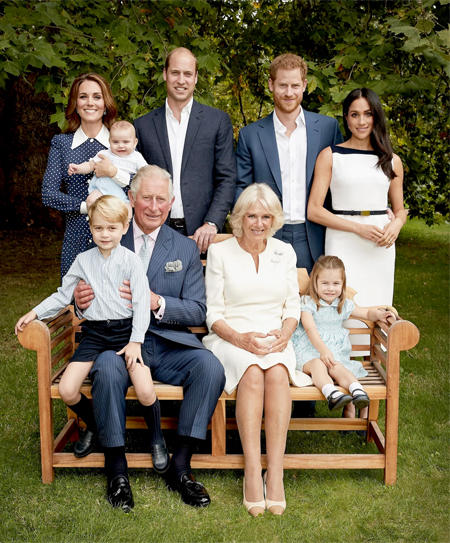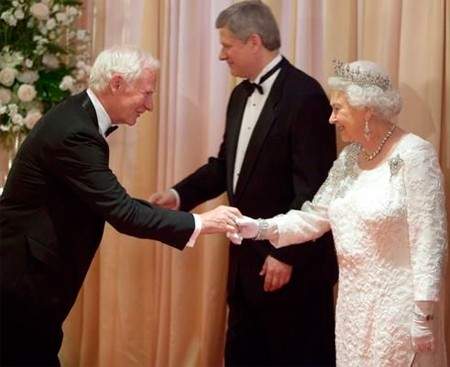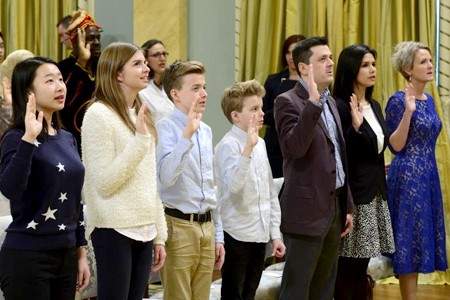The Monarchy in Canada
Many foreigners, and even some Canadians, are surprised to learn that Canada is a monarchy, which means the country’s political system is headed by a king or queen. Canada’s monarchy system is a bit more complicated and unusual than most others, however.
As we learned in the history chapter, Canada was once a colony of Britain, but unlike many of England’s other former colonies, Canada never made a sharp, clean break with the motherland. Canadian independence evolved slowly under British colonial supervision, and Canada’s system of government was largely copied from Britain — including a role for the British royal family.
Though Canada now has full political independence from the U.K., the British monarchy is still part of the Canadian political system to this day, in an unusual state of affairs that is sometimes described as a “shared monarchy” between Canada and Britain.
The “King of Canada”
Under the terms of the Canadian Constitution, the king or queen of the United Kingdom will always be recognized as the king or queen “of Canada,” as well. So the late Elizabeth II (1926-2022) was titled “Queen of Canada” during her long reign, and the new King of Canada is Charles III (b. 1948), and the future King of Canada will be his son, Prince William (b. 1982).
This arrangement allows Canada to still be “under” the British royals, while simultaneously allowing Canada to argue it has its “own” independent monarchy. In other words, Charles is supposed to consider his role as Canada’s king distinct from his role as Britain’s king, and so are the rest of us. He’s like an actor playing two different roles.
This unusual “sharing” of the British monarchy is not exclusive to Canada, however. About a dozen or so countries have a similar arrangement worked out with Britain’s monarch, notably Australia, Jamaica and New Zealand, as well as a few smaller island nations in the Caribbean and Pacific. At one time these countries were known as the dominions of the British Commonwealth, but in recent decades that term has fallen out of fashion and the Commonwealth has expanded into a much larger, more generic “make the world better” international organization featuring many member countries that have no links to the British crown — or even British history. Today, a country that shares the British crown is called a Commonwealth Realm. There are 15 in all.
Queen Elizabeth prepares to address the Canadian parliament in 1977.
Canadian Heritage
The Monarchy’s Political Role in Canada
Does the British king have any power over Canada? It’s a common question, but the answer is complicated. On the one hand, the monarch doesn’t do much. During her long reign, Queen Elizabeth only visited Canada occasionally and when she did, she mainly just cut ribbons, shook hands and smiled for photographers. On the other hand, the Canadian Constitution grants sweeping political powers to “the Queen,” declaring that “the executive government and authority of and over Canada” is vested in her. Among other things, the monarch is said to be head of Canada’s parliament and the commander-in-chief of the Canadian armed forces.
These two seemingly contradictory situations work together because Canada operates as what is called a constitutional monarchy, in which the monarch agrees to delegate powers to the nation’s elected politicians, rather than use them. In Canadian law, the impressive powers of the monarch are thus formally held by King Charles but lent to other people, mostly the Prime Minister of Canada (sometimes described as “his” prime minister), who governs on the King’s behalf and passes laws in his name using his royal authority. Canadian laws are often full of phrases like “Her Majesty requests” this, or “Her Majesty desires” that… it’s ceremony and theatre to honour the idea of delegated royal power. In reality, the Queen doesn’t care one way or another, and is not personally involved in these decisions.
Formally, King Charles is described as being Canada’s head of state — a symbolic figure of political authority — but the prime minister is called the head of government — the actual ruler of the country. The Crown is often used as a synonym for the entire Canadian government itself, such as Crown-owned land or the Crown’s lawyers.
His Majesty, by and with the advice and consent of the Senate and House of Commons of Canada, enacts as follows:
The first words of every bill introduced to the Canadian parliament.
The Canadian Monarchy Debate
Not everyone in Canada loves the monarchy. Polls suggest the country is actually split quite evenly on whether the institution is worth keeping. Is preserving constitutional ties to the monarchy something that strengthens Canadian patriotism and democracy? Or does it simply undermine Canada’s independence from Britain and bind the country to an out-of-date political system? It’s a debate that often pops up in the Canadian media, particularly whenever the royals come to town.
Though no major political party in Canada is officially in favour of cutting the country’s royal ties, there are two high-profile lobby groups that often debate the issue: the Monarchist League of Canada (pro) and Citizens for a Canadian Republic (anti). It’s not easy to generalize what sorts of Canadians support one side over the other. Support or opposition to the monarchy does not tend to be a neatly right or left wing issue, and on any given day you can find plenty of journalists, politicians, or academics willing to argue passionately for either side.
Monarchist Canadians argue that the monarchy is an important, unifying symbol of Canada’s history and heritage, and the King and his family are uplifting, positive role models — especially in contrast to divisive and unpopular politicians. Republicans, meanwhile describe the institution as something that makes Canada look like it’s still a colony without serving any important political function. The debate has been ongoing for decades, and for now, monarchists seem to have the upper hand. Most experts agree getting rid of the monarchy in Canada would require a constitutional amendment, and lacking much political pressure to initiate one, governments of both major parties have proven quite disinterested.
Prime Minister Stephen Harper (b.1959) sits under a portrait of the Queen in the cabinet room.
Stephen Harper/Flickr
Past Monarchs of Canada
Though some lists of “past Canadian monarchs” go all the way back to the French and English kings and queens of the 15th century — when the lands that are now Canada were first being settled by Europeans — the official government list only recognizes the post-1867 monarchs of the United Kingdom as true monarchs of Canada, since that was the year Canada’s modern-day Constitution — which enshrines the country’s current system of constitutional monarchy — was adopted.
Queen Victoria (served 1837-1901)
By the 19th century, Britain’s monarchs had already lost most of their political power, and Victoria’s (1819-1901) personal involvement with Canada came mostly in the form of naming cities and approving capitals. She remained highly venerated as a symbol of the British Empire’s glory, however, and Canadians still celebrate her birthday as an official holiday.
King Edward VII (served 1901-1910)
The eldest son of Victoria, Edward (1841-1910) made headlines in 1860 when he became the first British prince to visit North America, touring both Canada and the United States. Due to the length of his mother’s rule, he ascended to the throne as a relatively old man, and his reign was brief and mostly uneventful.
King George V (served 1910-1936)
The first monarch to be keenly aware of the power of the media, George V (1865-1936) helped popularize the modern idea of an image-conscious royal family. His reign also presided over an unprecedented transfer of political power to self-governing colonies like Canada, meaning a number of key constitutional laws from the era were passed in his name.
King Edward VIII (served 1936)
Edward (1894-1972) was a popular and charming prince, both in England and abroad, but he lacked a commitment to royal life. His desire to marry a twice-divorced American woman was considered scandalous in those more conservative times, and he was forced to resign less than a year after becoming king.
King George VI (served 1936-1952)
George (1895-1952) unexpectedly assumed the throne following his brother’s abdication. In 1939, he became the first British king to visit Canada, touring the country from coast to coast amid great spectacle. A symbol of perseverance during World War II (1939-1945), though he died young, his memory survived for a long time under his widow Elizabeth (1900-2002), the so-called “Queen Mother.”
Queen Elizabeth II (served 1952-2022)
Following her father’s death, Elizabeth (1926-2022) was the first British monarch to be specifically proclaimed “Queen of Canada.” Her 70-year reign — the longest in British history — saw the final dissolution of the British Empire into a symbolic “Commonwealth.” Elizabeth visited Canada 22 times, most recently in 2010. Her recent passing marked a symbolic close to a major period of the 20th century.
King Charles III (served 2022 to present)
The eldest son of Queen Elizabeth, Charles (b. 1948) is similar to Edward VII in that he spent a very long time serving as heir to his long-reigning mother. Best known for his ill-fated marriage to the glamorous Princess Diana (1961-1997), Charles has often struggled to remain popular in the age of tabloids. He has visited Canada almost as often as his mother, usually in Elizabeth’s “off-years.”
Charles the Third, by the Grace of God of the United Kingdom, Canada and His other Realms and Territories King, Head of the Commonwealth, Defender of the Faith.
The King’s full title in Canada, as proclaimed by the Governor General September 10, 2022
The Royal Family
The official British Royal Family is very large, and includes dozens of relatives of King Charles. However, the “royal family” most ordinary people are aware of only involves a small circle of the King’s closest family members, sometimes called the “senior royals.”
The King’s parents were the late Queen Elizabeth II (1926-2022) and her husband Prince Phillip (1921-2021), who was also known as the Duke of Edinburgh. Charles has two sons from his first wife, Princess Diana (1961-1997), Prince William (b. 1982) and Prince Harry (b. 1984). Charles and Diana divorced in 1996 and a year later she died in a car accident. In 2005 Charles married his current wife, Queen Camilla (full name: Camilla Parker Bowles, b. 1947). Prince William is married to Catherine “Kate” Middleton (b. 1982). After Charles became king the couple were retitled Prince and Princess of Wales. They have three children, the oldest being Prince George (b. 2013). In 2018 Prince Harry married an American woman named Meghan Markle (b. 1981). They’re also known as the Duke and Duchess of Sussex. They have two children, the oldest being Prince Archie (b. 2019). The Sussexes have infamously “opted-out” of royal duties.
The order of succession to the throne of Great Britain is governed by the Act of Settlement, an 18th century British law that describes in which order relatives of the current king or queen inherits the crown. In normal circumstances, the monarch’s eldest child takes over after the king or queen dies or abdicates (resigns), but if the monarch has no children it passes to his or her eldest sibling. The current order of succession goes: Prince William, Prince George, then William’s other children, followed by Harry and his children. Once Prince George has children, they will replace Harry and his children in the succession order.
Future Monarchs of Canada
Prince William
Charming Prince William (b. 1982), is the eldest son of King Charles and his late first wife. Considerably less controversial than his father, he remains the great hope for the future of the monarchy. Well-known for his quiet, unpretentious nature and popular wife, Kate Middleton (b. 1982), William often seems to be seeking a middle ground between being inoffensive and boring.
Prince George
Little George, the first child of Prince William and Princess Kate, was born in 2013 amid much hoopla. He is now second in line to the throne, after his father and grandfather, though he’ll probably be waiting a while.
Princess Charlotte
At present, Princess Charlotte (b. 2015), the second child of William and Kate, is third in line to the British throne, but statistically speaking, it’s unlikely she will ever take it. Based on how these sorts of things usually go, her older brother will probably get married and have children at some point, and those children will then out-rank her.
The King’s Representative in Canada
Preoccupied with their British duties, the monarch is only rarely in Canada. Yet the monarch’s many constitutional obligations to Canada means there are still a lot of papers to sign and approvals to give, even if they’re just formalities. In acknowledgement that the real monarch can’t be relied upon to perform these functions, the Canadian government employs an officer known as the Governor General of Canada who performs the duties of “acting monarch” inside Canada’s borders. The governor general is authorized to ceremonially sign and approve things on behalf of the king or queen, and in doing so ensures that Canada’s constitutional monarchy system continues to function properly, even in the absence of an actual monarch on Canadian soil.
To learn more, check out the Governor General of Canada chapter.
More About the Monarchy in Canada
